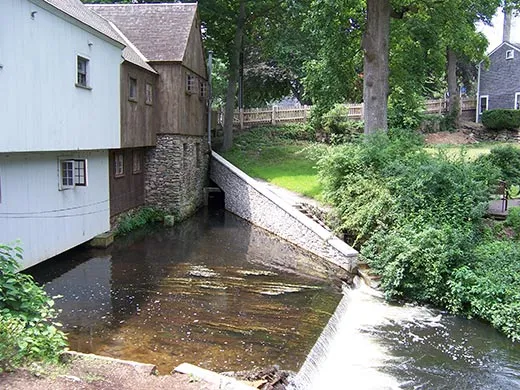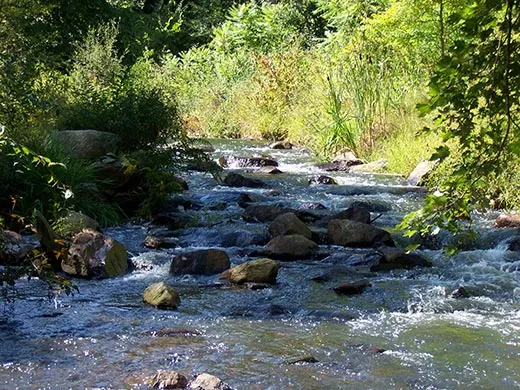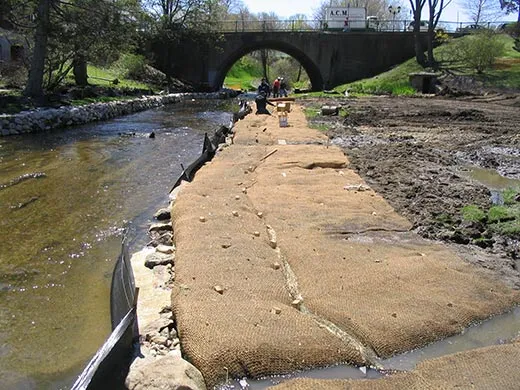The Waterway That Brought the Pilgrims to Plymouth
Town Brook gave sustenance to the Plymouth’s early settlers, but years of dam building have endangered the struggling stream
/https://tf-cmsv2-smithsonianmag-media.s3.amazonaws.com/filer/Plymouth-Town-Brook-631.jpg)
In the spring of 1621, Plymouth Colony’s Town Brook—the main water supply for the newly arrived Pilgrims—filled with silvery river herring swimming upstream to spawn. Squanto, the Indian interpreter, famously used the fish to teach the hungry colonists how to fertilize corn, by layering dead herring in with the seed. The resulting crop fueled festivities the following fall, at a celebration now known as the first Thanksgiving.
“That story that everyone learns as a kid?” says David Gould, environmental manager of Plymouth, Massachusetts, who oversees modern-day Town Brook. “This was that brook. These were those fish.”
But Town Brook—which helped support commercial life in Plymouth well into the 20th century—has been ailing for many decades now. Because of multiple dams constructed along the 1.5-mile stream, the historic herring runs have dwindled. Hundreds of thousands of fish once reached their spawning grounds each spring; today hardly any complete the journey on their own. To sustain the run, a state agency trucks thousands of additional herring to the head of the stream, where they are released to reproduce.
The town is now trying to restore the storied but struggling waterway. One of the six mostly defunct dams along the tiny snippet of river has been completely removed and another significantly lowered; the removal of two more could happen as early as this summer. The absence of these dams, and the help of recently improved fish ladders—artificial passages that let fish swim over dams—would let tens of thousands of herring breed unaided.
River restoration advocates hope the brook will be a model for other Northeastern waterways, which, from Pennsylvania to Maine, are constricted by an estimated 26,000 dams, many of them no longer in use because industry has moved elsewhere, but still blocking the passage of species like herring, Atlantic salmon and shad. Opponents of dam removal say that the effort to save fish obliterates too much local history.
It was the brook that enticed the first settlers to Plymouth. The Mayflower initially landed in Provincetown, at the tip of Cape Cod. But the hundred-odd Pilgrims were wary of the scarcity of fresh water on the sandy peninsula, especially since their supplies of beer, the preferred puritanical refreshment, were running low.
They rounded the tip of the cape and sailed across to mainland Massachusetts, where they spied what one person later described as “a very sweet brook,” fed by cool springs of “as good water as can be drunk.” The brook’s mouth was a convenient salt marsh, where the colonists could anchor their boats. And not far from where the brook met the sea was what would later become an extremely famous rock.
The settlers built their houses close by, and an early encounter with the Indians occurred “across the valley of Town Brook,” Nathaniel Philbrick wrote in Mayflower: A Story of Courage, Community, and War. “The Indians gestured for them to approach. The Pilgrims, however, made it clear that they wanted the Indians to come to them.” Along with water and fish, the brook supplied eels (Squanto, for one, knew how to trample them out of the mud) and plenty of waterfowl, which flocked to the little pond at its source that they called, rather grandly, Billington Sea.
The colonists soon discovered even more uses for the brook. Almost totally dependent on European imports when they first arrived, they needed to manufacture necessities, and dams provided power. The first corn mills were built along the brook in the 1630s—prior to that, the Pilgrims pounded corn into flour by hand.
Other water-powered mills followed, to treat wool and, later, produce leather and snuff. The Town Brook’s mills became still more important after the Revolutionary War. Since much of the town fishing fleet was captured or sunk in the Revolution (the remainder was mostly finished off in the War of 1812), the locals were eager to find land-based employment in the mills, which soon focused on iron production and paved the way for the Industrial Revolution, making everything from nails to shovels.
But wildlife suffered. The dams and their millponds raised water temperatures in parts of the stream and decreased dissolved oxygen levels, and primitive fish ladders didn’t allow many herring through. Eventually, much of the mill industry moved to the South and the dams fell into disrepair – yet the fish were still cut off from their spawning grounds.
“At one point there were seven dams over the course of a mile and a half,” says David Gould, the environmental manager. “That’s a lot of obstructions for a fish to migrate through in such a short distance. That’s simply devastating to a population.”
The initial dam removal, in 2002, was the first of its kind in coastal Massachusetts. The community has also worked on modernizing fish ladders, diverting polluted storm water flows, and preserving land around the Billington Sea.
Most New England dams are quite small compared with their western counterparts—perhaps 10 to 20 feet tall. But to fish, “even a two-foot dam is a barrier,” says Brian Graber, director of the Northeast river restoration program of American Rivers, a nonprofit group involved with the Town Brook project. Throughout New England, removing aging dams is usually much cheaper than updating them, and many of the region’s dams are becoming safety hazards. In one town or another, “We’re having public safety emergencies pretty much every time there’s a big storm,” Graber says.
At the moment, New England dams are being demolished at the rate of a dozen per year. Scores are currently being considered for destruction in Massachusetts alone. Yet removing the dams—which can mean draining historic millponds, not to mention bulldozing and replanting river channels—changes the aesthetics of rivers and eliminates structures that may trace their roots back centuries.
Some worry that removing Town Brook’s dams will erase an important chapter of history. In its present form, the brook “is a microcosm of the evolution of American life” across four centuries, telling the story of how religious refugees became farmers and fishermen, then millworkers, and finally, suburban commuters, says Jim Baker, a Plymouth historian and author of Thanksgiving: The Biography of an American Holiday. “There’s plenty of brooks around and plenty of fish. But once you take out history, it’s never coming back.“
These sentiments are common in lesser-known communities throughout New England. Many times “a dam was built and the town grew around the business,” explains Eric Hutchins, a National Oceanic and Atmospheric Administration fisheries biologist involved with the Town Brook project. “It’s often a place where grandparents worked and children played. A lot of these towns get their names from dams.”
On Town Brook, a compromise of sorts has been struck. Though the restoration team hopes to remove or lower five of the six dams, they currently have no plans for the most historic structure—the dam at the site of a 1636 mill, where a re-created gristmill still operates today. Workers instead installed a state-of-the-art aluminum fish ladder, carefully lining it with stone to blend in with the mill, a popular tourist site.
But these days, Gould notes, the strengthening herring run is a tourist attraction all on its own.


